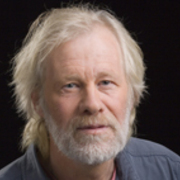
Alun Bollinger
Since the 1960s, Alun Bollinger has worked with almost every significant Kiwi movie director: among them Geoff Murphy, Ian Mune, Gaylene Preston, Vincent Ward, Roger Donaldson, Peter Jackson and Jane Campion.
Aged 18, Bollinger joined the NZ Broadcasting Corporation as a trainee cameraman. He developed his craft shooting on 16mm for news and current affairs shows. Outside of work hours, he was also making films with teacher and musician Geoff Murphy. Bollinger even appeared in short film The Box, as a pop star pursued by fans. The closing shot showed a van with the name The Acme Sausage Company. Murphy decided it would make a great name for his film company; Bollinger liked the fact that ASC also happened to be the initials of the American Society of Cinematographers.
Later Bollinger and his family would spend time living in Hawke's Bay, in what he called “a communal set-up with a film connection, with people like Bruno Lawrence, Martyn Sanderson, Geoff Murphy and their families … lots of kids”. Among other creative endeavours, Bollinger and others from the Blerta co-op were developing their craft on a variety of screen projects — 1970 robbery tale Tank Busters, an early te reo version of the Uenuku legend, the slapstick of Percy the Policeman, and their first, underfunded attempt at a feature, 1977's Wild Man, which began as an episode of the Blerta TV series. Bollinger can be seen talking about Wild Man in documentary Cowboys of Culture.
In 1977 Bollinger worked as gaffer (chief electrician) and special effects man on Roger Donaldson feature Sleeping Dogs, which is often listed as the relaunch point for New Zealand cinema. Bollinger went on to shoot several features in quick succession: Middle Age Spread, (1979); Sons for the Return Home (1979); and Beyond Reasonable Doubt (1980).
Bollinger then worked with camera operator Graeme Cowley on Geoff Murphy's breakthrough hit Goodbye Pork Pie (1981). Very little of the film could use synchronised sound, due to a noisy old Arriflex camera and the many scenes shot inside noisy cars and train carriages. In 1984 Bollinger followed it with another classic: over-the-top comedy Came a Hot Friday; Ian Mune directed.
It was with his other film that year, the dark and beautifully crafted Vigil, that Bollinger established his distinctive cinematographic style. Set entirely on a rural farm, the film won rapturous reviews overseas. Bollinger had previously worked with director Vincent Ward on two shorter films, A State of Siege (1978), adapted from the novel by Janet Frame, and In Spring, One Plants Alone (1980), a poetic documentary about an isolated Māori woman and her schizophrenic son in the Urewera. Bollinger would return as director of photography on the troubled shoot for Ward's colonial epic River Queen, at one point even finding himself briefly taking on directing duties.
After Bollinger's awardwinning work on the movie of iconic Kiwi play The End of the Golden Weather, he was invited by Peter Jackson to film 1994's Heavenly Creatures. The film incorporates a highly mobile camera and expressionistic use of colour and lighting, though the tones grow progressively darker in later scenes.
The rush of acclaim for Heavenly Creatures meant international recognition for Bollinger's work. But he has largely resisted the temptation to work overseas. To date, he has left Aotearoa for only four projects: Larry Parr's French-set A Soldier's Tale, Isle of Man-shot curiosity Woundings, his "flawless" images (David Stratton) on Australian romance For Love Alone, and Kiwi-born director Anna Reeves' Oyster Farmer, which saw him nominated for a slew of Aussie awards.
Following Heavenly Creatures, Bollinger reteamed with Peter Jackson for Jackson's next two films. Mockumentary Forgotten Silver saw Bollinger deliberately filming scenes out of focus, or undercranking the camera to recreate the required silent movie look. Meanwhile big-budget ghost tale The Frighteners involved roughly 500 effects shots, and one of the longest shoots on Kiwi soil to date. Bollinger collaborated with cinematographer John Blick, after a car accident saw him sidelined from the project for a month.
Bollinger's collaborations with director Gaylene Preston cross the gamut: from the documentary work of War Stories and filming Bollinger's late family friend Hone Tuwhare, to big screen West Coast thriller Perfect Strangers. His small screen work includes 2021 TV movie The Tender Trap, and a number of projects with director Yvonne Mackay — among them TV movie The Haunting of Barney Palmer, and 90-minute Jean Batten ballet Jean.
In 2012 Bollinger joined Mexican-born director Dana Rotberg on locally-shot culture-clash tale White Lies. Bollinger has worked with many emerging filmmakers, including Andrea Bosshard and Shane Loader (The Great Maiden's Blush), Emily Corcoran (The Stolen), and Paul Wolframm (Bollinger was Moa nominated for Wolframm's 2014 documentary Voices of the Land: Ngā Reo o te Whenua).
Documentary Barefoot Cinema: The Art and Life of Cinematographer Alun Bollinger turned the camera on Bollinger himself, with illuminating results. The barefooted Bollinger continues to spend half of each year working on selected features, documentaries and short films. In 2024he sat down for this extended interview with NZ On Screen.
- This profile is partly adapted from Duncan Petrie's book Shot in New Zealand - The Art and Craft of the Kiwi Cinematographer.
Profile updated on 8 September 2025
Sources include
'ScreenTalk Legends - Alun Bollinger' (Video Interview) NZ On Screen website. Director Kathryn Quirk. Loaded 15 August 2024. Accessed 15 August 2024
Duncan Petrie, Shot in New Zealand - The art and craft of the Kiwi cinematographer (Auckland:Random House, 2007)
Roger Booth, Bruno - The Bruno Lawrence Story (Christchurch: Canterbury University Press, 1999)
Nancy Cawley, 'Old Man River' (Interview) - The Listener, 13 May 2006 (Issue 203)
David Stratton, The Avocado Plantation - Boom and Bust in the Australian Film Industry (Sydney: Pan Macmillan Publishers Australia, 1990)